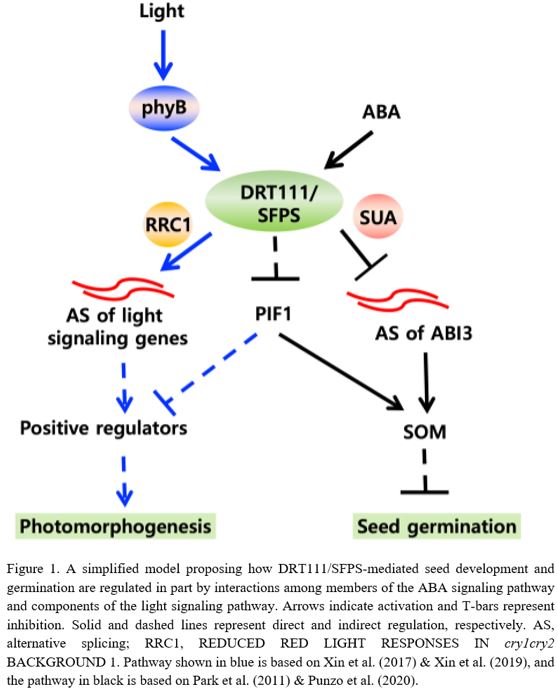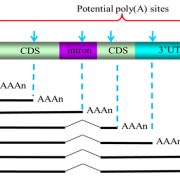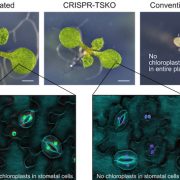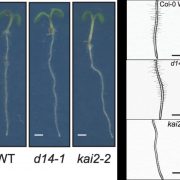SPLICEd in the Seeds: Integration of ABA and Light Signaling in Arabidopsis
Dhineshkumar Thiruppathi 1,2
Donald Danforth Plant Science Center,
Saint Louis, Missouri 63132
1Author for contact: [email protected]
2Lead author
 Plant development and adjustment to the environment require not only tight regulation of core signaling pathways but also their integration in a time- and context-dependent manner. For example, seed germination and seedling development are coregulated by endogenous hormonal cues such as abscisic acid (ABA) and by external environmental stimuli such as light (Lau and Deng 2010). ABA inhibits seed germination, and light subsequently modulates ABA balance for photoautotrophic seedling establishment (Chen et al. 2008). The molecular players governing core ABA and light signaling pathways are regulated by alternative or precursor mRNA (pre-mRNA) splicing, a post-transcriptional mechanism by which a single gene is transcribed into various mRNA isoforms. Nonetheless, how such regulation integrates ABA and light signaling pathways is still something of a mystery. In this issue of Plant Physiology Punzo et al. (2020) report that DNA-DAMAGE REPAIR/TOLERATION PROTEIN 111 (DRT111) links ABA- and light-regulated pathways to negatively control seed germination sensitivity to ABA through specific splicing events (Fig.1). DRT111 is a protein related to human splicing factor 45 (SPF45) and was first identified as SPLICING FACTOR FOR PHYTOCHROME SIGNALING (SFPS) in light-regulated development of Arabidopsis (Arabidopsis thaliana; Xin et al. 2017). DRT111/SFPS promotes photomorphogenesis by interacting with the photoreceptor phytochromes (phyB) and regulating pre-mRNA splicing of genes involved in light signaling (Fig.1).
Plant development and adjustment to the environment require not only tight regulation of core signaling pathways but also their integration in a time- and context-dependent manner. For example, seed germination and seedling development are coregulated by endogenous hormonal cues such as abscisic acid (ABA) and by external environmental stimuli such as light (Lau and Deng 2010). ABA inhibits seed germination, and light subsequently modulates ABA balance for photoautotrophic seedling establishment (Chen et al. 2008). The molecular players governing core ABA and light signaling pathways are regulated by alternative or precursor mRNA (pre-mRNA) splicing, a post-transcriptional mechanism by which a single gene is transcribed into various mRNA isoforms. Nonetheless, how such regulation integrates ABA and light signaling pathways is still something of a mystery. In this issue of Plant Physiology Punzo et al. (2020) report that DNA-DAMAGE REPAIR/TOLERATION PROTEIN 111 (DRT111) links ABA- and light-regulated pathways to negatively control seed germination sensitivity to ABA through specific splicing events (Fig.1). DRT111 is a protein related to human splicing factor 45 (SPF45) and was first identified as SPLICING FACTOR FOR PHYTOCHROME SIGNALING (SFPS) in light-regulated development of Arabidopsis (Arabidopsis thaliana; Xin et al. 2017). DRT111/SFPS promotes photomorphogenesis by interacting with the photoreceptor phytochromes (phyB) and regulating pre-mRNA splicing of genes involved in light signaling (Fig.1).
In a previous study the authors had identified genes upregulated in potato (Solanum tuberosum L.) cells adapted to long-term exposure to osmotic stress and ABA (Ambrosone et al., 2017). In the current study, they use bioinformatic analysis to identify Arabidopsis orthologs of the potato genes along with DRT111. The ABA-dependent expression of DRT111 was confirmed by real-time PCR and promoter-ß-glucuronidase assays. Mutation of DRT111 resulted in hypersensitivity to ABA in seed germination and seedling root growth assays, and reduced sensitivity to ABA in stomatal responses—typical phenotypes of ABA-signaling mutants. When overexpressed, DRT111 reversed a subset of these mutant phenotypes. The authors further characterized the role of DRT111 in seed germination through transcriptome sequencing of drt111 seeds and found that the negative influence of DRT111 on germination was partly due to its effect on the expression and splicing of genes involved in not only ABA-, but also light-dependent control of germination. In the drt111 mutant, they found that several A. thaliana HDzip genes, the targets of ABA INSENSITIVE3 (ABI3), PhyA, PHYTOCHROME INTERACTING FACTOR1 (PIF1), and PIF6 were all upregulated, whereas the drt111 mutant led to a downregulation of PhyE, PhyD, and PIF7.
The authors next examined the splicing of seed-specific mRNAs likely to affect seed germination. They found, in drt111 seeds, substantial alterations in splicing pattern in the mutant, with a majority of the affected genes related to germination and mRNA metabolism. Among these genes, they noticed a defective splicing of ABI3 in drt111 seeds, consistent with the deregulation of ABI3 target genes in drt111 RNA-seq. ABI3 is a key player determining ABA sensitivity at the seed stage and is under the control of another splicing factor SUPPRESSOR OF ABI3-5 (SUA; Sugliani et al. 2010). Through double and triple mutant analyses they confirmed that DRT111 and SUA likely work in the same pathway to control ABI3 splicing during seed germination.
As it was known that DRT11/SFPS modulates PIFs to promote photomorphogenesis (Xin et al. 2017), the authors hypothesized that DRT111 marks a major point of convergence between ABA and light in the control of seed germination. The SOMNUS (SOM) gene is an important target for of ABI3-PIF1 transcriptional activation that normally inhibits seed germination (Park et al. 2011). Punzo et al. found that mutating DRT111 resulted in SOM expression in seeds. Conversely, mutation of PIF1 alone or with additional PIFs, which decrease SOM expression, led to ABA insensitivity in seed germination.
The model that emerges is one in which DRT111 modulates the splicing of ABI3 (and additional factors), in turn targeting the expression of ABA/light signaling genes to regulate seed germination (Fig. 1). Such a splicing module adds an additional level of regulation for flexible integration of hormone and environmental cues to coordinate growth and stress responses. This model fits with the ABA hypersensitivity of phyB mutants in seed germination, which implies a role for light in regulating DRT111-dependent splicing events, an interesting possibility that has yet to be experimentally tested.
LITERATURE CITED
Ambrosone A, Batelli G, Bostan H, D’Agostino N, Chiusano ML, Perrotta G, Leone A, Grillo S, Costa A (2017) Distinct gene networks drive differential response to abrupt or gradual water deficit in potato. Gene 597: 30–39
Chen H, Zhang J, Neff MM, Hong S-W, Zhang H, Deng X-W, Xiong L (2008) Integration of light and abscisic acid signaling during seed germination and early seedling development. Proc Natl Acad Sci U S A 105: 4495–4500
Lau OS, Deng XW (2010) Plant hormone signaling lightens up: integrators of light and hormones. Curr Opin Plant Biol 13: 571–577
Park J, Lee N, Kim W, Lim S, Choi G (2011) ABI3 and PIL5 collaboratively activate the expression of SOMNUS by directly binding to its promoter in imbibed Arabidopsis seeds. Plant Cell 23: 1404–1415
Sugliani M, Brambilla V, Clerkx EJM, Koornneef M, Soppe WJJ (2010) The conserved splicing factor SUA controls alternative splicing of the developmental regulator ABI3 in Arabidopsis. Plant Cell 22: 1936–1946
Xin R, Kathare PK, Huq E (2019) Coordinated Regulation of Pre-mRNA Splicing by the SFPS-RRC1 Complex to Promote Photomorphogenesis. Plant Cell. doi: 10.1105/tpc.18.00786
Xin R, Zhu L, Salomé PA, Mancini E, Marshall CM, Harmon FG, Yanovsky MJ, Weigel D, Huq E (2017) SPF45-related splicing factor for phytochrome signaling promotes photomorphogenesis by regulating pre-mRNA splicing in Arabidopsis. Proc Natl Acad Sci U S A 114: E7018–E7027









